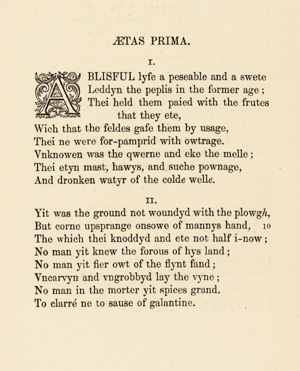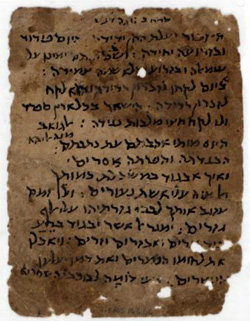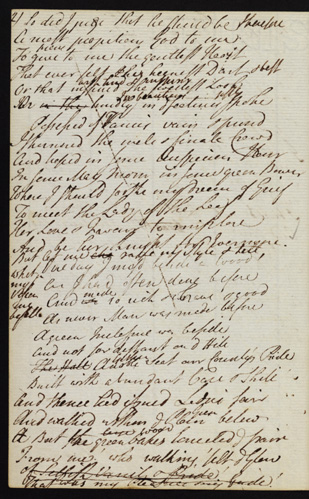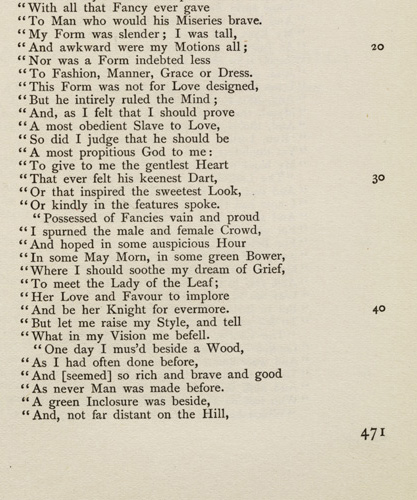WRITING POETRY: TEXT AND ARTEFACT IN CAMBRIDGE UNIVERSITY LIBRARY
John Wells
A version of this article was first published in P. N. Review, volume 30, no. 5 (May-June 2004), pp. 25-29.
 |
| The first printed version of Chaucer’s ‘The former age’, edited by Richard Morris, London, 1866. Morris used the Library’s MS Hh.4.12 as his copy text, taking the title ‘Ætas prima’ (‘The first age’) from the colophon there. XXIX.10.28, p. 300. |
Exhibiting manuscripts has much in common with compiling anthologies. To refine a substantial collection of documents to a few dozen items under glass entails a similar process of sifting, selection and rejection to that of reducing a field of literature to a single volume. Exhibitions, like anthologies, are all the better for having points to make and arguments to develop, while related fears dog both editor and curator: the significant work not remembered, the choice manuscript lying unrecognised in its box. The fundamental difference between the projects is that an exhibition treats words not only as texts but as artefacts. ‘Writing Poetry’ aims to show how poetry has been transmitted in writing since before the time of Christ to within the last decade, but also explores the ways in which literary and historical interest accrues to written words.
When Philip Larkin drew his well-known (in library circles) distinction between the ‘meaningful’ and ‘magical’ values of literary manuscripts, he confined the ‘magic’ to the moment of a work’s composition: ‘these are the words as he wrote them, emerging for the first time in this particular miraculous combination.’1 Magic, however, is not restricted to autograph literature: there are more ways than one for papyrus, vellum or paper to acquire fascination. The oldest document in the exhibition is a fragment of the Euripides play ‘Iphigenia in Tauris’ from around 250 BC, its constituent flecks of papyrus, carefully positioned in a frame, resembling a satellite photograph of the Philippines. The pieces were retrieved early in the twentieth century from a mummy in a Ptolemaic necropolis outside the Nile town of Hibei. A large number of literary fragments was discovered at the site, leading the excavators from the Egypt Exploration Fund to conclude that a classical library had been broken up for its papyrus and in part recycled as mummy ‘cartonnage’ – the strips of tightly-pressed papyrus layered around an embalmed body. The Fund distributed its finds widely between libraries and museums in Britain, Europe, Egypt and the United States, and the Euripides papyrus, MS Add. 4461, forms one of several accessions by the University Library from Hibei and other sites at Oxyrhynchus (modern Behnesa) and Fayum. Remarkably, given how little remains, the fragment allowed two editorial conjectures concerning the text of the play to be confirmed, and supplied other useful readings.
 |
| Poems written by Dunash ibn Labrat (c. 920-990) and his wife, from the Taylor-Schechter Genizah Collection. T-S NS 143.46 |
Another manuscript which, coincidentally, was also shipped from Egypt to England, barely six years earlier, combines a remarkable story of survival with still greater intrinsic interest. In 1896-97 Solomon Schechter, Reader in Talmudic and Rabbinic literature in Cambridge, travelled to Cairo to investigate the Genizah of the Ben Ezra Synagogue in Fostat (Old Cairo). A Genizah is a storeroom chiefly intended to preserve dilapidated copies of sacred writings from destruction at human hands, but the assiduity of the Ben Ezra officials had led to a vast body of both religious and secular documents being accumulated over the synagogue’s thousand-year existence. Schechter, alerted to the Genizah by a fragment purchased in Cairo by two scholarly Cambridge sisters, Agnes Lewis and Margaret Gibson, which he identified on their return from Egypt as a section of the then-unknown Hebrew version of Ecclesiasticus, obtained the permission of the Chief Rabbi to excavate the Genizah. He eventually oversaw the removal of some 140,000 fragments to the University Library, where for several decades they remained only partially sorted and conserved. In 1984 Ezra Fleischer, Professor of Hebrew Literature at the Hebrew University of Jerusalem, working on a project to identify and catalogue the poetic fragments, announced the discovery of an unknown poet: the wife of Dunash ibn Labrat. Dunash, who lived in the tenth century, was already celebrated as the earliest of the Judeo-Spanish school of poets, and the fragment, MS T-S NS 143.46, barely four inches by five in area, bears verses he exchanged with his wife before his apparently enforced departure from Spain. His wife’s poem tells of the lovers’ exchange of a ring, wristband, mantle and veil as tokens of loyalty, and asks, in a dignified elegiac tone, whether the gift of half the realm would prevail on him to stay in Spain. ‘Mrs Dunash’ is the only female Jewish poet to have been identified between the biblical prophetess Deborah and the late middle ages. After its long wait in the dry, dark atmosphere of the synagogue attic, her formal and deeply expressive poem has been heard anew.
| Part of a poem from The craftsman, No. 185, January 1730. ‘W–––’ is Robert Walpole, ‘N–––k’ is Norfolk, his home county, and H––v––r is Hanover. Daniel Defoe and Nathaniel Mist both stood in the pillory after convictions for libel. |
While Euripides was a famous writer and Mrs Dunash clearly a fine one, the exhibition also includes three of the thousands of metrical squibs produced in Britain in the course of eighteenth-century factional wrangling by authors who show scant literary accomplishment beyond a certain snappish verve. The documents on display nevertheless powerfully evoke the restrictive political culture of Sir Robert Walpole’s England: seized during a raid on the Covent Garden printing shop of Richard Francklin, publisher of the seditious newspaper The Craftsman, each bears the docket ‘Scrutore’, dated 3 September 1730 and initialled by the government agents who examined them. A creased front-page proof of the edition of the Craftsman intended for publication on 5 September 1730 lies in the same file, with a contemporary note that it was taken in the printer’s composing room, ‘as I believe out of Mr Francklin’s pocket’. Confiscation of property was a common government tactic, and Francklin was accustomed to arrests and ransackings; these poems were never restored to him, and they are now held among Walpole’s private papers as MS Ch(H) 74/20, 24 and 49. Many of the Craftsman’s correspondents submitted their work anonymously to avoid being implicated in prosecutions, and of the three poems only one, ‘Bob Booty’s Epitaph’, has a named author, William Comber. The writer of ‘Poor Robin’s Lamentation Transvers’d & Explained’ suggested how tiresome Walpole found the opposition presses:
What tho’ his merit does not fear ‘em?
His mortall patience cannot bear ‘em;
Fables and Stories prose and verse
O! Misery of Ministers!
Bob Booty and Poor Robin were nicknames for Walpole, the former familiar from the Beggar’s Opera.
A draft of the first stanza of 'Willow Song' by Anne Stevenson, 1983, from MS Add. 9451 I went down to the railway (From The Collected Poems of Anne Stevenson 1955-1995, published by Bloodaxe Books.) |
Perhaps the exhibition’s most striking example of manuscripts that acquired their importance subsequent to their writing are two collections of rubáiyát by Omar Khayyám, from MS Add. 4510. Cambridge University Library would not normally rank among its treasures a copy of a copy of a manuscript in the Bodleian, but the transcript in question, made in an octavo booklet bound in fading violet card, bears an inscription inside the front cover over the initials of the Sanskrit scholar Edward Byles Cowell: ‘This is the copy which I made from my own transcript of the Bodleian MS of Omar Khayyám … & gave to FitzGerald in June 1856. We were both staying at my Mother’s house at Rushmere near Ipswich, before I went to India. I read the Persian with him.… This transcript first introduced Omar to his future translator.’ The earliest feelers towards the most popular of all translations into English verse are visible in the annotations – usually single words serving as reminders of the meanings of Persian terms – made by Edward FitzGerald in pencil and turquoise ink in the margins and between the lines of the tetrastichs on these pages. Exhibited alongside the booklet is a second set of rubáiyát, in a more substantial notebook, which was prepared for FitzGerald at Cowell’s behest by an Indian scribe from a copy in the library of the Bengal Asiatic Society. This is the manuscript which FitzGerald described as a ‘scrawl’ – ‘the errors and omissions come in batches’ – but of which he nevertheless wrote to Cowell that it had ‘the human Interest which all MSS have beyond Printed Books – written by a living hand at the end of which was a living Soul like my own’.2
FitzGerald’s rubáiyát are a prime example of poems moving, through translation, from one cultural role to another. The function of manuscripts in the transmission and dissemination of literary culture, and the use made of manuscripts by scholars, whether academic or, as in FitzGerald’s case, private, are linked themes highlighted at several points in the exhibition. Almost all printed poems have an initial manuscript or typescript existence, and the conditions and duration of the journey into print frequently influence the text and reception of the poem. It is in the establishment of reliable texts that poetry manuscripts, scholarship, and the wider readership of poetry converge. Several of the exhibition’s illustrated wall-panels depict early printed texts of poems, edited from manuscripts on view in the cases. Thus the discreet footnote in John and George Smith’s great Cambridge University Press edition of Bede’s Historiæ Ecclesiasticæ of 1722, presenting Cædmon’s Hymn as part of an academic critical publication, is pictured beside the Moore manuscript of Bede, MS Kk.5.16, written a millennium earlier, from which the text was derived. The Library holds the only two known medieval texts of Chaucer’s ‘The Former Age’, one interpolated in a magnificent copy of his English version of the Boethius ‘De consolatione philosophiae’, MS Ii.3.21, the other found in a compilation of early English poetry, MS Hh.4.12. Both are displayed in the exhibition, alongside a panel illustration of the poem’s first printing, the Richard Morris Aldine edition of 1866 using Hh.4.12 as the copy text. A case of drafts, with autograph poems by Shelley, Tennyson, Rudyard Kipling and Anne Stevenson, and corrected type by Milton and Seamus Heaney, includes an early version of one of Crabbe’s ‘Tales of the Hall’, from a notebook held as MS Add. 4422, which was edited by A. W. Ward in 1907; a passage from the printed version is illustrated nearby. When we read popular editions of old poets, the nature of the sources and the processes of editorial intervention are easily overlooked; ‘Writing Poetry’ illuminates the bond between the manuscript as artefact and the poem as text.
 |
 |
| ‘The amours of G’, an early draft by George Crabbe of his poem ‘The elder brother’, c. 1815. MS Add. 4422, f.61v. | A section of the first printed version of ‘The amours of G[eorge]’, edited by Adolphus William Ward from George Crabbe’s notebook, MS Add. 4422. Lit.7.90.919, p. 471. |
Some poetry can never be realised as fully in print as in manuscript. The twelfth-century manuscript of ‘De laudibus sanctae crucis’, MS Add. 4078, a sequence of devotional poems by the ninth-century Abbot of Fulda and Archbishop of Mainz, Hrabanus Maurus, is barely recognisable as verse. The poems are written in small rustic capitals on square or rectangular grids, each line in a grid corresponding to a line of verse. The lines of each poem contain, with few exceptions, identical numbers of characters, and the regular positioning imposed by the grids gives them uniform spatial lengths. In visual terms therefore the line – the fundamental distinction of poetry as a form – is undermined. The spare austerity of the grids is offset by colourful decorations in red, green, yellow, blue and brown, mostly geometric shapes or larger letters drawn over the small capitals, but also including representations of angels, evangelistic symbols, and, in the displayed poem, the crucified Christ. These drawings and patterns isolate groups of letters within the basic text spelling out further words and phrases. Letters written in red on Christ’s limbs, and others under shading in his loincloth and halo, are examples of such ‘intexts’; the letters in the halo, for example, read ‘Rex regum et d[omi]n[u]s dominorum’. In the example illustrated on the exhibition wall-panel, the large capitals of CRUX SALUS have the same function. In the printed editions, produced from the early sixteenth century onwards, the inability of the typesetters to represent the figure-drawing and colouring of the originals materially distorted the poet’s conception. In ‘De laudibus sanctae crucis’, fully-achieved texts are inseparable from manuscript artefacts.
| “Salve sancta salus Christi…”, the third poem in the series ‘De laudibus sanctae crucis’ by Hrabanus Maurus, in its figured format, from a German manuscript of the early twelfth century. MS Add. 4078, f.6v. |
Two display cases examine the place of poetry as an activity pursued within the University. The central position of rhetoric in the medieval and early-modern curriculum fostered both the study and the writing of poetry, and the ability to turn a graceful verse was deemed as worthy an accomplishment in a scholar as in a courtier. A visit to Cambridge made by Elizabeth I in 1564 occasioned the compilation of a volume of some three hundred sets of congratulatory verses, in Latin, Greek, Hebrew, Aramaic and English, speedily composed with rather varying degrees of competence by members of the colleges. Having originally suggested the form of the compliment, Elizabeth’s Secretary, Sir William Cecil, apparently kept possession of the completed article, as the volume was in the possession of his family until after the Restoration; it is now MS Add. 8915. University plays of the sixteenth and seventeenth centuries, the influence of a few of which may be traced in more popular English drama of the period, were often composed wholly or partially in verse. The Library’s MS Ff.2.9 is a well-written seventeenth-century copy of William Alabaster’s tragedy ‘Roxana’, which in Samuel Johnson’s judgement contained the best Latin verse written in England prior to the elegies of Milton. The play’s effectiveness in performance is suggested by the author of the Anglorum speculum (1684), who reported that a gentlewoman present at a performance in the hall of Trinity College, ‘hearing of the last words thereof, Sequar, Sequar, so hideously pronounced, fell distracted, and never after recovered her Senses.’3 The manuscript is exhibited at a less climactic point.
| The title panel from ‘The lovers of Gudrun’ by William Morris, written in gold on prepared vellum by William Graily Hewitt, 1908-9. MS Add. 6162. |
MS Add. 3873 is a volume of ‘Act-verses’ circulated in the late sixteenth century in the course of the public Acts – disputations, examinations, and defences of dissertations – required for admission to a degree. The poems treated the theses under discussion, and reflect the University’s function of preparing men for holy orders. Composed for the most part in Latin elegiacs or hexameters, and commonly concluding with an ‘ergo’ resolving the argument in Latin or in Greek iambics or sapphics, they are carefully written out, usually in practised humanistic roman or italic hands. Forming part of the rite of passage from academic to clerical life, or else from one stratum to another within the university, the poems reveal a post-Reformation generation anxiously articulating Establishment orthodoxy. The dutiful weighing-up and consent to Protestant doctrine (‘Missa non est sacrificium propitiatorium’; ‘Corpus Christi non est ubique’) shaded into the belligerent posturing provoked by themes such as ‘Papatus est tyrannio’ and ‘Pontifex Romanus est ille Antichristus, quem futurum scriptura prædixit’ (this last example being somewhat uncertainly ascribed to John Whitgift by a Registrary looking over the papers in the 1750s). The volume serves as a corrective to idealistic notions of verse as a medium for seeking after truth: egged on by the authorities they were bent on satisfying, the writers sustained the defensive intellectual culture which accorded merit to their poems.
A different spirit pervaded the University two centuries later, when in 1792 the Vice-Chancellor announced as the theme for the odes competing for Browne Medals ‘Sors misera servorum in insulis Indiæ occidentalis’: the miserable destiny of slaves in the islands of the West Indies. (The theme in 1790 had been an even more topical ‘Bastilia expugnata’.) The Greek Ode medallist in 1792 was Coleridge, and his autograph copy of the poem, written out in a large, deliberate hand in the book laid on the Registrary’s table for inspection at Commencement, CUA Char.I.4, is displayed in the exhibition. Coleridge’s effort was the butt of the tale, told anonymously by John Wilson in Blackwood’s Edinburgh Magazine in 1817, that Richard Porson had offered to show 134 examples of bad Greek in the ode. James Diggle demonstrated the flimsiness of this charge in an examination of the poem’s grammar and metre published in Notes and Queries in 2002, but an entertainingly malicious story of almost two hundred years’ standing will not easily be snuffed. Browne’s benefaction survives to the present day, although the restriction of competition to undergraduates, coupled with the decline of classical language teaching in schools, means that medals are nowadays more often offered than awarded. Faithful to the topicality demanded by the form, subjects for Latin epigrams in recent years have included spin-doctors, genetically modified foods, and Posh ‘n’ Becks.
| John Donne’s poem ‘The flea’, from the Leconfield manuscript written in England c.1620-1632. MS Add. 8467, f.94r. |
The exhibition’s final case holds three examples of manuscript verse notable as calligraphy, each having a distinct degree of textual authority. A two-foot-square sheet of paper bearing eight large cursive characters is a holograph and possibly impromptu couplet written for the Library by a visiting Chinese ambassador in 1999, and represents a living tradition of marking formal and festal occasions with calligraphic exercises. The Leconfield manuscript of poems of John Donne, MS Add. 8467, written before the first printing of Donne’s Poems, is a fine example of a seventeenth-century English Italianate book hand; the volume is respected by editors as one of a small number of manuscripts which, in Herbert Grierson’s words, ‘show that their collectors had a clear idea of what were, and what were not, Donne’s poems’.4 The grandest of the three concluding exhibits, MS Add. 6162, is a copy by William Graily Hewitt, the calligrapher most widely encountered through the scroll sent to relatives of the fallen in the First World War, of ‘The Lovers of Gudrun’ by William Morris, the medieval tale for November in ‘The Earthly Paradise’. Done in gold on vellum, bound and cased in tooled leather, it was commissioned by Charles Fairfax Murray in 1908, forty years after the poem’s publication. The written words themselves have no scholarly value: Hewitt indubitably copied a standard printed source, and any discrepancies between his and Morris’s version are merely slips. Splendid though the penmanship may be, no-one whose primary interest is an appreciation of the poem would elect to read it here: the effortful regularity of the crisp gilt lettering rapidly tires the eye. It is difficult, indeed, to imagine the two-hundred-odd pages ever having been read through by anyone except Hewitt and – possibly – Murray. In practical terms the manuscript barely functions as a text at all: it is a poem as artefact entire.
Notes
1. Philip Larkin, ‘A neglected responsibility’, in Required writing: miscellaneous pieces 1955-1982 (London: Faber and Faber, 1983), 99. Back to text
2. Edward FitzGerald to E. B. Cowell, May-August 1857, in Alfred McKinley Terhune and Annabelle Burdick Terhune, The letters of Edward FitzGerald (Princeton: Princeton University Press, 1980), volume II, 274 and 293. Back to text
3. Anglorum speculum: or, the worthies of England… (London: printed for John Wright, Thomas Passinger and William Thackary, 1684), 789. Back to text
4. Herbert J. C. Grierson, The poems of John Donne edited from the old editions and numerous manuscripts with introductions & commentary (Oxford: Clarendon Press, 1912), volume II, lxxxiii. Back to text